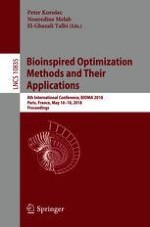2018 | OriginalPaper | Chapter
Indicator-Based Versus Aspect-Based Selection in Multi- and Many-Objective Biochemical Optimization
Authors : Susanne Rosenthal, Markus Borschbach
Published in: Bioinspired Optimization Methods and Their Applications
Publisher: Springer International Publishing
Activate our intelligent search to find suitable subject content or patents.
Select sections of text to find matching patents with Artificial Intelligence. powered by
Select sections of text to find additional relevant content using AI-assisted search. powered by
